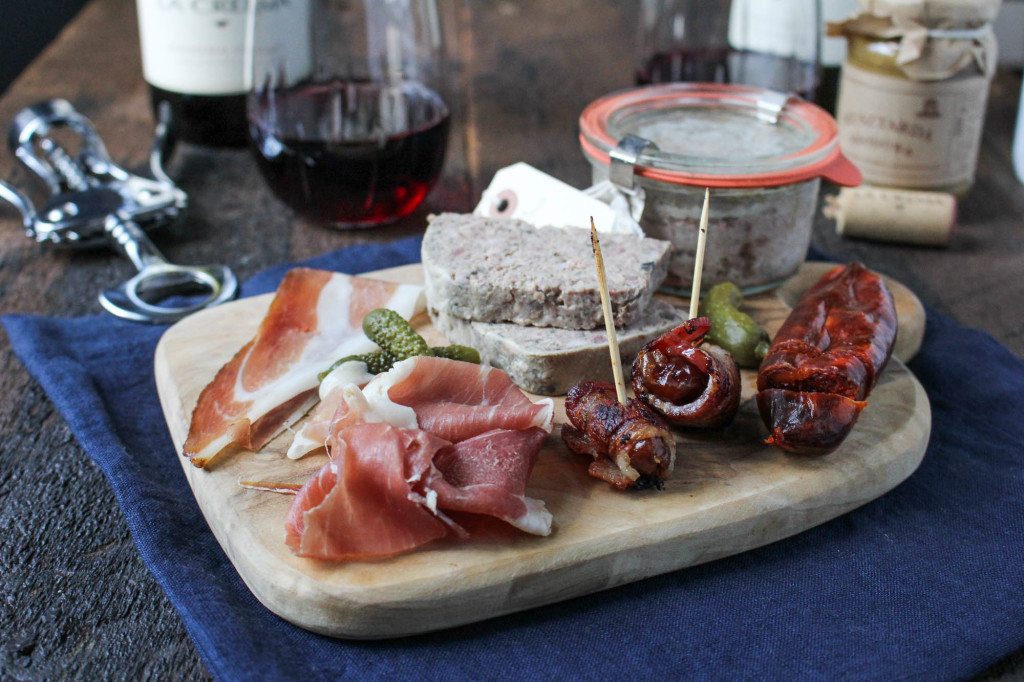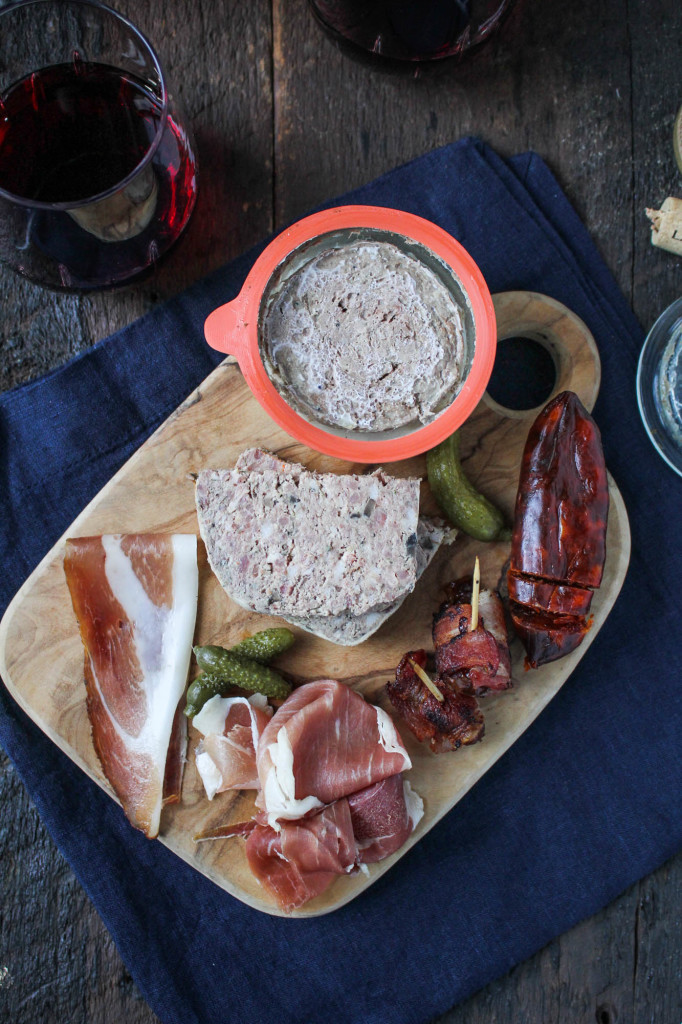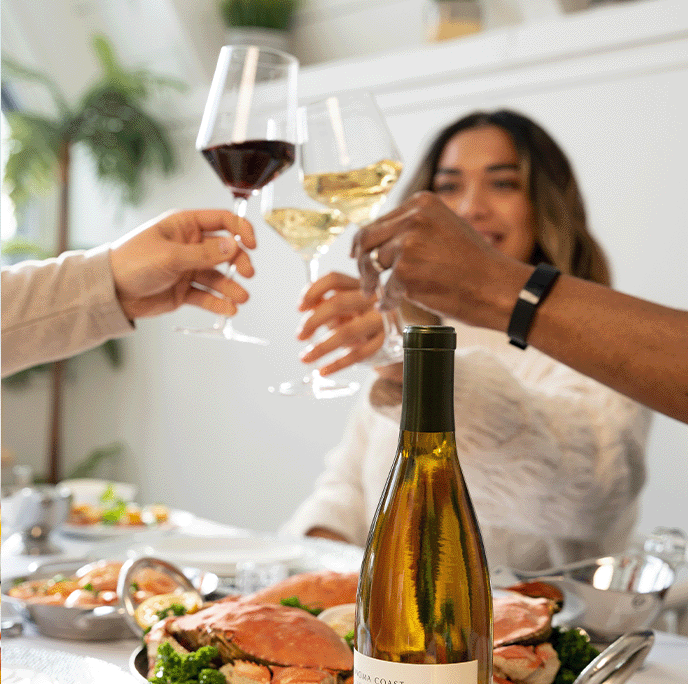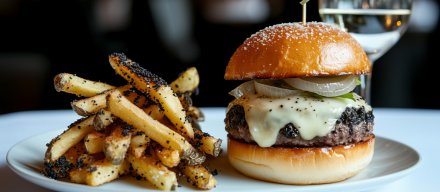Charcuterie and Wine 101: Building The Perfect Board
I think the best part of dinner parties may be the pre-dinner part. Standing around the kitchen island, chatting with friends while you finish up the cooking, sipping wine, and nibbling on whatever easy, tasty appetizers you’ve thrown together. Sometimes, the appetizers steal the show from the rest of the meal, but I don’t think anyone minds.
Cheese and nice artisan crackers are always irresistible, but a good charcuterie board? Now that’s a showstopper. Especially since the artisan charcuterie trend has gained momentum over the past few years. Now, when you go into your local butcher or cheese shop, there are better choices than ever. Speck, prosciutto, terrine, pate, chorizo, rillettes, salami – the options are numerous, global, and all delicious.
What is Charcuterie?
Charcuterie is a French term that refers to the art and technique of curing, smoking, and preserving meat products. This culinary practice has been around for centuries and originated as a way to preserve meats before refrigeration was available.
Today, charcuterie has evolved into a gourmet form of snacking and entertaining, with various types of cured meats, pâtés, terrines, and other delicacies being enjoyed around the world. To create the perfect charcuterie board, there are a few essential components that you’ll need to keep in mind.
The Essential Charcuterie Board Components
Creating the perfect charcuterie board involves more than just arranging meats and cheeses; it’s about balancing flavors, textures, and colors to create a visually appealing and delicious spread. Here are the essential components to include:
Meats for a Charcuterie Board
- Prosciutto: This Italian dry-cured ham is thinly sliced, served raw, and known for its delicate, buttery texture with a slightly salty and sweet flavor.
- Salami: Varieties of salami are made from ground pork seasoned with herbs and spices before being cured, adding a savory punch of flavor and texture to any board.
- Chorizo: Originating from Spain, chorizo is a spicy cured sausage made with pork, garlic, and smoked paprika, providing a bold flavor that pairs well with tangy cheeses.
- Coppa: Also called capicola, this Italian dry-cured ham from the neck or shoulder is richer and more marbled than prosciutto, with a slightly spiced and fatty flavor.
- Bresaola: This Italian air-dried beef offers a lighter, healthier option with its deep red color and delicate flavor, complementing creamy cheeses and crisp fruits.
Cheese for a Charcuterie Board
- Soft Cheeses: Start with cheeses that offer a creamy, melt-in-your-mouth texture. Brie and Camembert are excellent choices here. Their rich, buttery flavors pair beautifully with a range of wines, from sparkling varieties like Champagne to fruity reds like Pinot Noir (we love it with La Crema Sonoma Coast Pinot Noir). The creamy texture also contrasts nicely with the saltiness of cured meats.
- Hard Cheeses: Add some aged hard cheeses for a different texture and flavor profile. Cheddar, Gouda, and Parmesan bring a robust and sometimes nutty flavor that pairs well with fuller-bodied wines. Try them with a bold Cabernet Sauvignon or a spicy Zinfandel. These cheeses offer a satisfying bite and can stand up to the strong flavors of cured meats.
- Blue Cheeses: For a bold and distinctive choice, include some blue cheese like Roquefort or Gorgonzola. These cheeses have a tangy, pungent flavor that pairs exceptionally well with sweet wines like Port or Sauternes. The contrast between the cheese’s strong flavors and the sweetness of the wine creates a memorable taste experience.
- Fresh Cheeses: Fresh cheeses like goat cheese or ricotta add a light and tangy element to your board. Their mild flavor makes them versatile and pairs well with crisp white wines like Sauvignon Blanc or sparkling wines. They also work nicely with a variety of fruits and nuts.
- Specialty Cheeses: Don’t be afraid to get a little adventurous. Consider adding some unique or artisanal cheeses to surprise your guests. Cheeses with herbs, spices, or even smoked varieties can add an extra layer of flavor to your charcuterie board. Pair these with wines that have a bit of complexity to match the cheese’s distinctive taste.
When selecting cheeses, aim for a variety of textures and flavors to keep things interesting. The key is to balance the richness of the cheeses with the different wines you’re serving, ensuring that each combination offers a delicious and complementary experience. Want to learn more about wine and cheese? Check out our definitive blog on wine country cheese and wine pairings.
Accompaniments for a Charcuterie Board
It is always wise to include a variety of accompaniments that complement the meats, cheeses, and wines:
- Crackers and Bread: Offer a mix of crisp crackers and soft baguette slices to provide a versatile base for cheeses and spreads.
- Fresh and Dried Fruits: Add fresh fruits like grapes and dried fruits such as apricots for a sweet contrast to the rich flavors of the board.
- Nuts: Include almonds, walnuts, or cashews to add a crunchy texture and nutty flavor that complements the cheeses and meats.
- Pickles and Olives: Provide tangy pickles and briny olives to cut through the richness and add a zesty flavor to the board.
- Spreads and Condiments: Feature mustards, honey, and chutneys to offer additional layers of flavor and enhance the overall taste experience.
- Vegetables: Fresh vegetables like cherry tomatoes and cucumber slices add a refreshing crunch and cleanse the palate.
- Herbs and Garnishes: Use fresh herbs like rosemary or thyme to add a pop of color and aromatic notes to your presentation.
The Best Wine for Charcuterie
Whether you prefer red, white, rosé, or sparkling, choosing a wine that complements the diverse flavors of the meats and cheeses is key to a successful pairing.
Pinot Noir: This red wine is a top choice for charcuterie boards due to its light to medium body and vibrant acidity. Pinot Noir’s subtle fruit notes and earthy undertones pair wonderfully with a range of charcuterie, from creamy cheeses to savory cured meats. It’s particularly good with dishes like prosciutto and mild cheeses.
Cabernet Sauvignon: For a bolder option, Cabernet Sauvignon is a great match. Its full body and robust tannins work well with richer, more flavorful charcuterie such as aged cheeses and heavily seasoned meats. The wine’s dark fruit flavors and hints of spice can stand up to the intense flavors of items like salami and smoked sausages.
Sauvignon Blanc: This white wine is known for its crisp acidity and bright citrus flavors. Sauvignon Blanc pairs exceptionally well with fresh and soft cheeses, as well as tangy charcuterie like pâté. Its acidity helps cut through the richness of creamy cheeses and balances the saltiness of cured meats.
Chardonnay: For a fuller-bodied white, Chardonnay is a solid choice. The wine’s buttery texture and notes of vanilla and oak complement richer cheeses such as Brie and aged Gouda. Chardonnay’s complexity makes it versatile enough to handle a variety of charcuterie elements.
Rosé: Rosé wine offers versatility with its crisp acidity and red fruit flavors. It pairs well with a wide range of charcuterie, including both cured meats and cheeses. The wine’s light and refreshing character makes it a great all-rounder, fitting seamlessly with different textures and flavors on the board.
Sparkling Wines: Sparkling wines are fantastic for their ability to cleanse the palate between bites. The effervescence helps cut through rich and fatty charcuterie, while their bright acidity complements a variety of cheeses and meats.
Why Do Charcuterie and Wine Work So Well Together?
When it comes to food and drink pairings, charcuterie and wine are a match made in heaven. But what makes these two work so well together?
The varied textures and flavors of charcuterie—think salty cured meats, creamy cheeses, and crunchy nuts—interact beautifully with wine. For example, the saltiness in prosciutto can make a light white wine’s fruit flavors pop, while the richness of a creamy cheese can be mellowed by a wine’s acidity. On the flip side, a bright, acidic wine like Sauvignon Blanc cuts through the richness of creamy cheeses, providing a refreshing contrast. Rich, bold reds like Cabernet Sauvignon work wonders with the saltiness of cured meats, smoothing out the wine’s tannins and boosting its flavor.
Simply put, charcuterie and wine bring out the best in each other. They create a balanced and enjoyable tasting experience, making each sip and bite even more satisfying.
How to Make a Charcuterie Board
Now for a little Charcuterie 101. A good charcuterie board should have at least three elements – one that’s rich and unctuous, like prosciutto; one that’s salty, sliceable, and a bit herbal, like salami or chorizo; and one that’s sweeter and spreadable, such as a nice pate. After you have the basics, you can get creative – add more pork, a bit of mustard, some rosemary crostini to spread the pate on, and perhaps some cornichon pickles to cut the richness. The focus, however, should remain on the meat, so don’t get too crazy with the accoutrements! If you’re feeling ambitious, adding a few cooked elements to the plate can really enhance things. Bacon-wrapped dates are an easy and utterly addictive addiction. A few slices of sautéed pork belly is a bit more time consuming, but will really impress your guests.
Now that you know the basics, let’s dive into the 7 simple steps for creating the perfect charcuterie board.
7 Simple Steps for Building the Perfect Charcuterie Board
Step 1: Start with a Base
Choosing the right base for your charcuterie board is important as it sets the stage for all the delicious ingredients. As mentioned before, wooden boards are a classic choice and provide a warm and rustic feel. But don’t be afraid to get creative – use slate boards, marble slabs, or even cutting boards for a unique look. Just make sure your board is large enough to fit all your ingredients without feeling crowded.
Step 2: Select Your Meats
The key here is variety. Aim for 3-4 types of cured meats to provide a range of flavors and textures. Prosciutto, salami, pancetta, and soppressata are all popular choices. You can also mix in some unique options like duck prosciutto or venison salami for a more adventurous palate.
Step 3: Add Some Cheese
No charcuterie board is complete without cheese! Aim for a variety of textures and flavors – soft and creamy brie, sharp cheddar, tangy blue cheese, and mild gouda are all great options. Consider adding in some unexpected cheeses like goat cheese or manchego for an extra kick.
Step 4: Don’t Forget the Accompaniments
This is where you can get creative and add some extra pizzazz to your charcuterie board. Olives, pickles, nuts, dried fruit, and honey are all great options for adding different flavors and textures. You can also include spreads like fig jam or mustard for a little something extra.
Step 5: Include Some Crunch
Crusty bread or crackers are a must-have on any charcuterie board. Not only do they provide a satisfying crunch, but they also help balance out the rich and savory meats and cheeses. Consider offering a variety of breads or crackers to cater to different dietary preferences.
Step 6: Finish with Wine
Last but certainly not least, it’s time for the perfect wine pairing. As a general rule, white wine pairs well with lighter meats and red wine pairs well with richer, fattier meats. However, don’t be afraid to try different combinations and see what works best for your taste buds.
Step 7: Assemble Your Charcuterie Board
Now that you have all your ingredients, it’s time to assemble your charcuterie board. Here’s a simple guide:
- Start by placing larger items such as cheese and bowls of spreads on the board first.
- Fill in any gaps with meats and accompaniments, leaving some space between each item for easy serving.
- Add a decorative touch by drizzling honey or sprinkling herbs over the board.
- Don’t be afraid to get creative with the presentation – use different shapes and sizes of ingredients to add visual interest to your board.
And voila! Your beautiful and delicious charcuterie board is ready to be enjoyed. Bon appétit!
Make Every Charcuterie and Wine Pairing a Winner with La Crema
Upgrade your charcuterie board with La Crema, known for its award-winning wines from California’s best vineyards. Since 1979, we’ve focused on crafting quality wines like our Pinot Noir, Chardonnay and now Cabernet Sauvignon.
Whether you’re hosting friends or celebrating a special occasion, La Crema wines enhance every bite and create memorable moments together. Explore our collection and make your next gathering unforgettable!
Related Blogs:










Comments